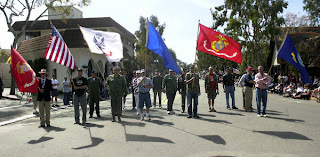The LB General Plan Land Use Element
Pictured is the 17 February 2012 revision of the Laguna Beach Land Use Element, one of seven elements in a General Plan specified by California statute. In 2008 California's legislature passed a law requiring after January 1 2011, any substantive revision of a Circulation Element of a General Plan, the transportation system of a city must plan for a balanced, multimodal transportation network that meets the needs of all roadway users for safe and convenient travel.
Known as the California Statute for Complete Streets, Gov. Code section 65302(b)(2)(A,B) says the General Plan shall consist of text setting forth objectives, principles, standards and planning proposals to build streets usable by "bicyclists, children, persons with disabilities, motorists, movers of commercial goods, pedestrians, users of public transportation, and seniors."
Complete Streets code also says the Circulation Element must be correlated with the Land Use Element. That means that when the Circulation Element is revised to plan for a balanced, multimodal transportation network, it must also be consistent with the Land Use Element. Typically, both must be revised simultaneously to ensure mutual compatibility. Since the Laguna Beach Circulation element was not updated, it is necessary to update both documents now.
In fact, guidelines from the State Office of Planning and Research tell us the road system proposed in the circulation element must be "closely, systematically, and reciprocally related to the land use element of the plan ..." (case law). Another citation says the Elements "form an integrated, internally consistent plan of which all parts are equally weighted in their application ..." (case law). That makes it necessary to amend both elements together. The guidelines say local governments may not amend any one of the mandatory elements of the general plan more than four times in one calendar year (§65358(b)). That does not appear to be an issue for Laguna Beach.
So Laguna Beach now faces a dilemma. If the city chooses to delay updates to their Circulation Element, the Land Use Element remains uncorrelated with transportation planning and the GP is thereby out of conformance with Government Code section 65302. If the city chooses to update both elements but ignores its obligation to plan for all users of the transportation system, then the City of Laguna is not complying with State law.
Kids, seniors, and disabled folks are left out -- sometimes in dangerous positions in the roadway risking life and limb (Aliso Bridge). That's not right and it's not legal.
We deserve better.
Known as the California Statute for Complete Streets, Gov. Code section 65302(b)(2)(A,B) says the General Plan shall consist of text setting forth objectives, principles, standards and planning proposals to build streets usable by "bicyclists, children, persons with disabilities, motorists, movers of commercial goods, pedestrians, users of public transportation, and seniors."
Complete Streets code also says the Circulation Element must be correlated with the Land Use Element. That means that when the Circulation Element is revised to plan for a balanced, multimodal transportation network, it must also be consistent with the Land Use Element. Typically, both must be revised simultaneously to ensure mutual compatibility. Since the Laguna Beach Circulation element was not updated, it is necessary to update both documents now.
In fact, guidelines from the State Office of Planning and Research tell us the road system proposed in the circulation element must be "closely, systematically, and reciprocally related to the land use element of the plan ..." (case law). Another citation says the Elements "form an integrated, internally consistent plan of which all parts are equally weighted in their application ..." (case law). That makes it necessary to amend both elements together. The guidelines say local governments may not amend any one of the mandatory elements of the general plan more than four times in one calendar year (§65358(b)). That does not appear to be an issue for Laguna Beach.
So Laguna Beach now faces a dilemma. If the city chooses to delay updates to their Circulation Element, the Land Use Element remains uncorrelated with transportation planning and the GP is thereby out of conformance with Government Code section 65302. If the city chooses to update both elements but ignores its obligation to plan for all users of the transportation system, then the City of Laguna is not complying with State law.
Kids, seniors, and disabled folks are left out -- sometimes in dangerous positions in the roadway risking life and limb (Aliso Bridge). That's not right and it's not legal.
We deserve better.
-LS









